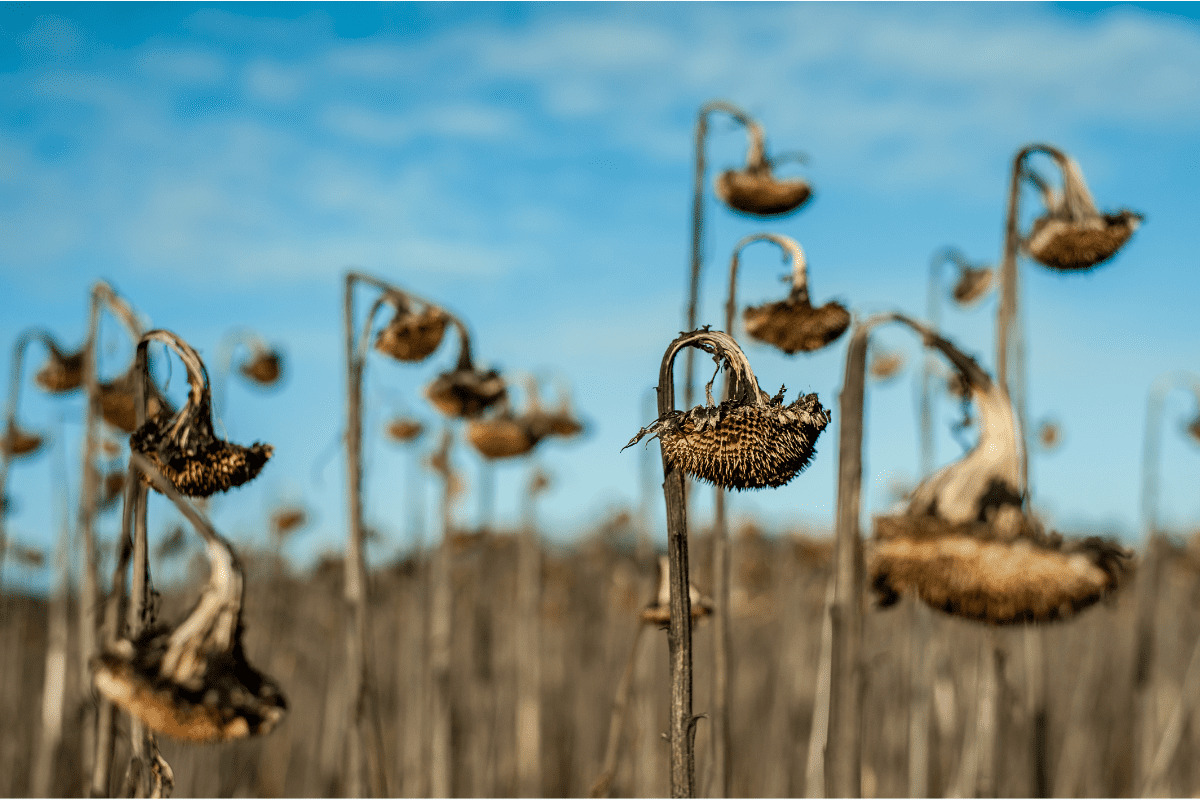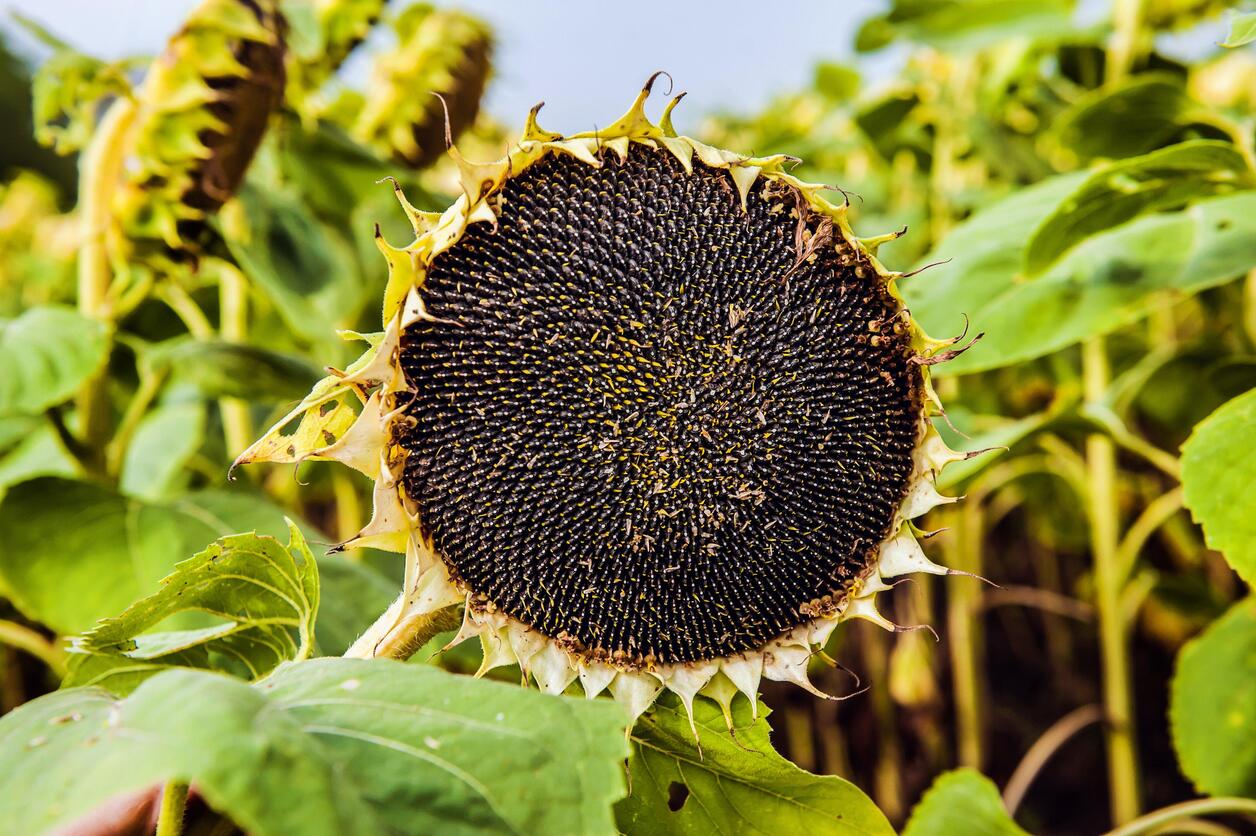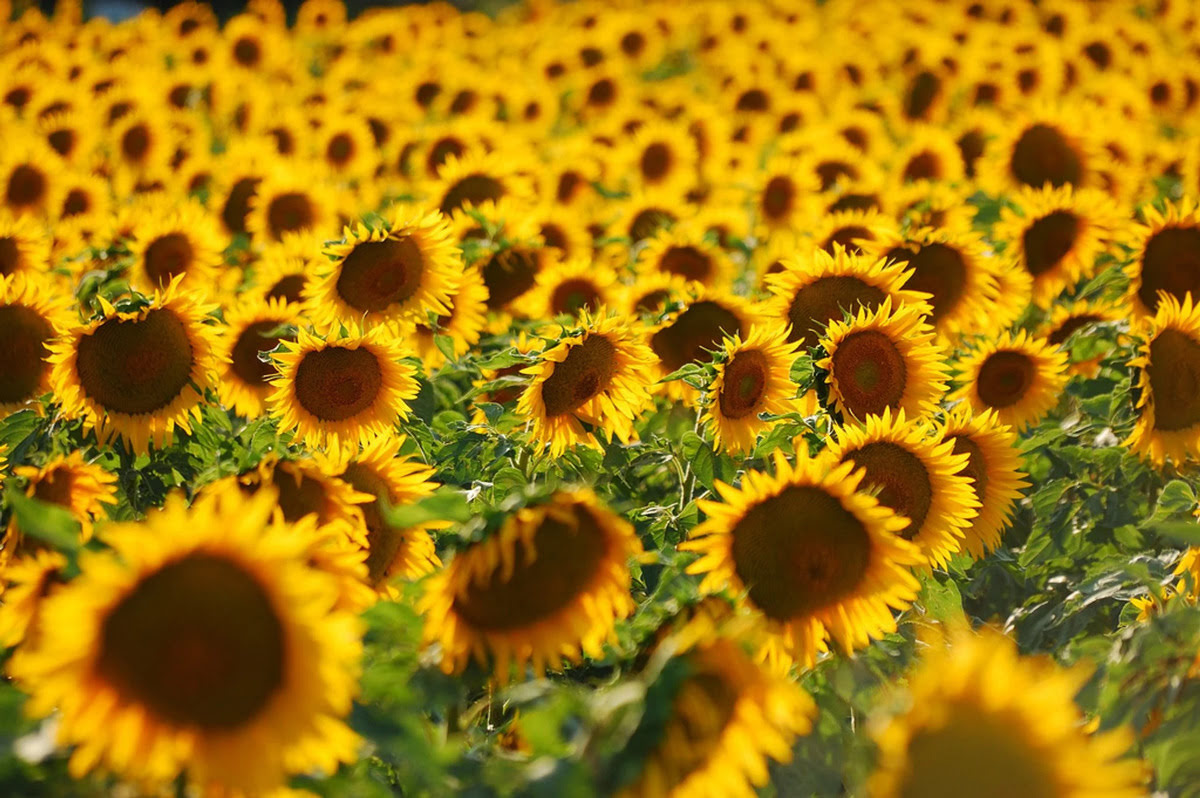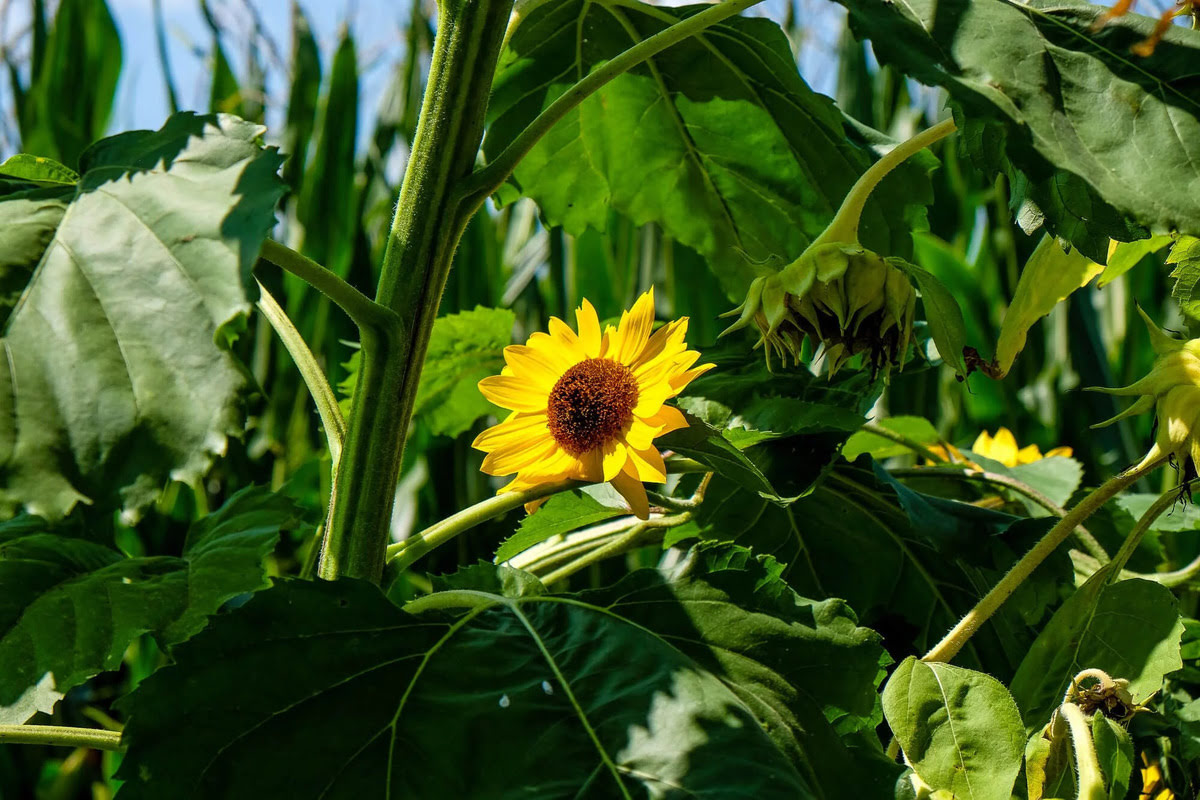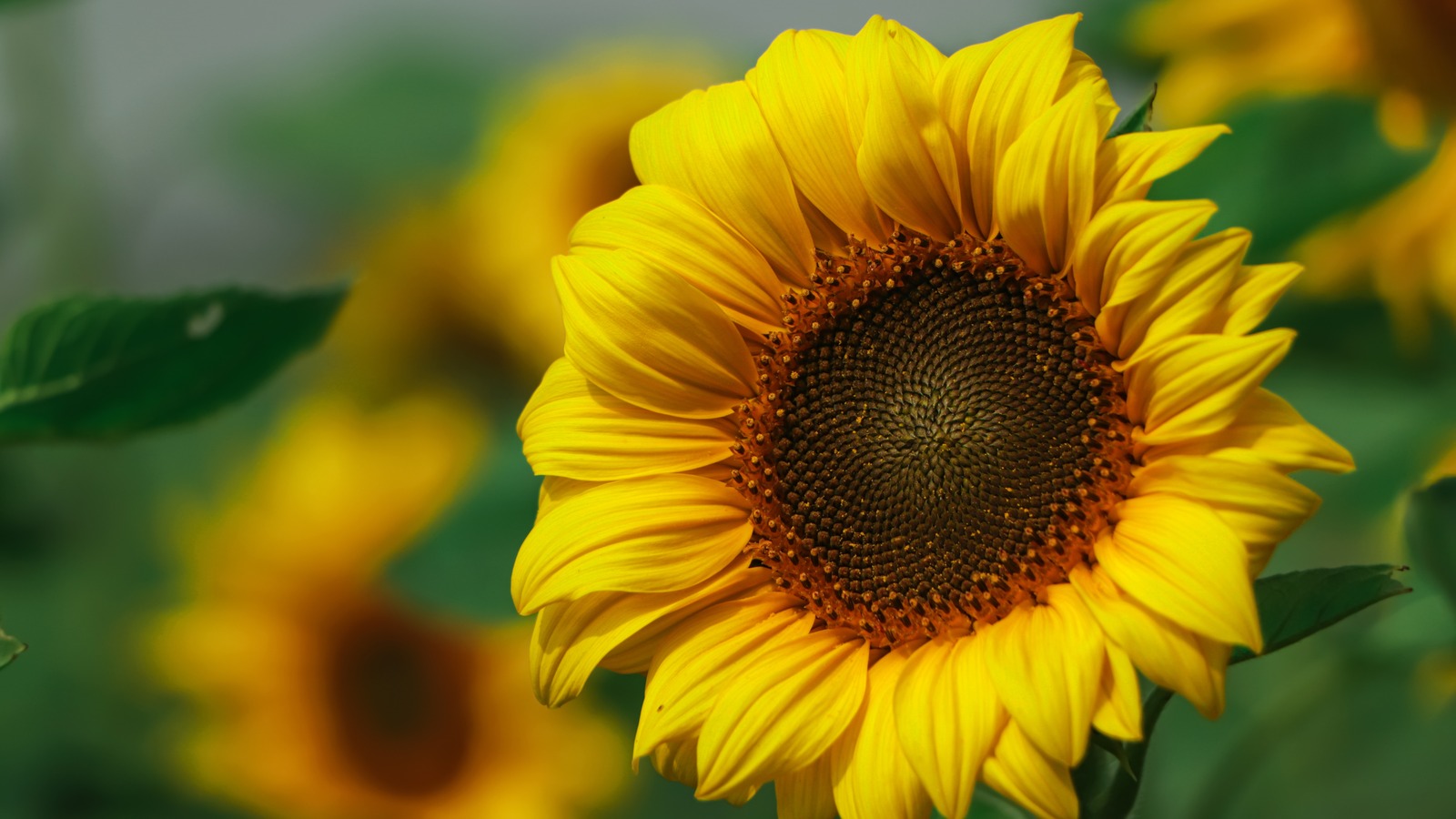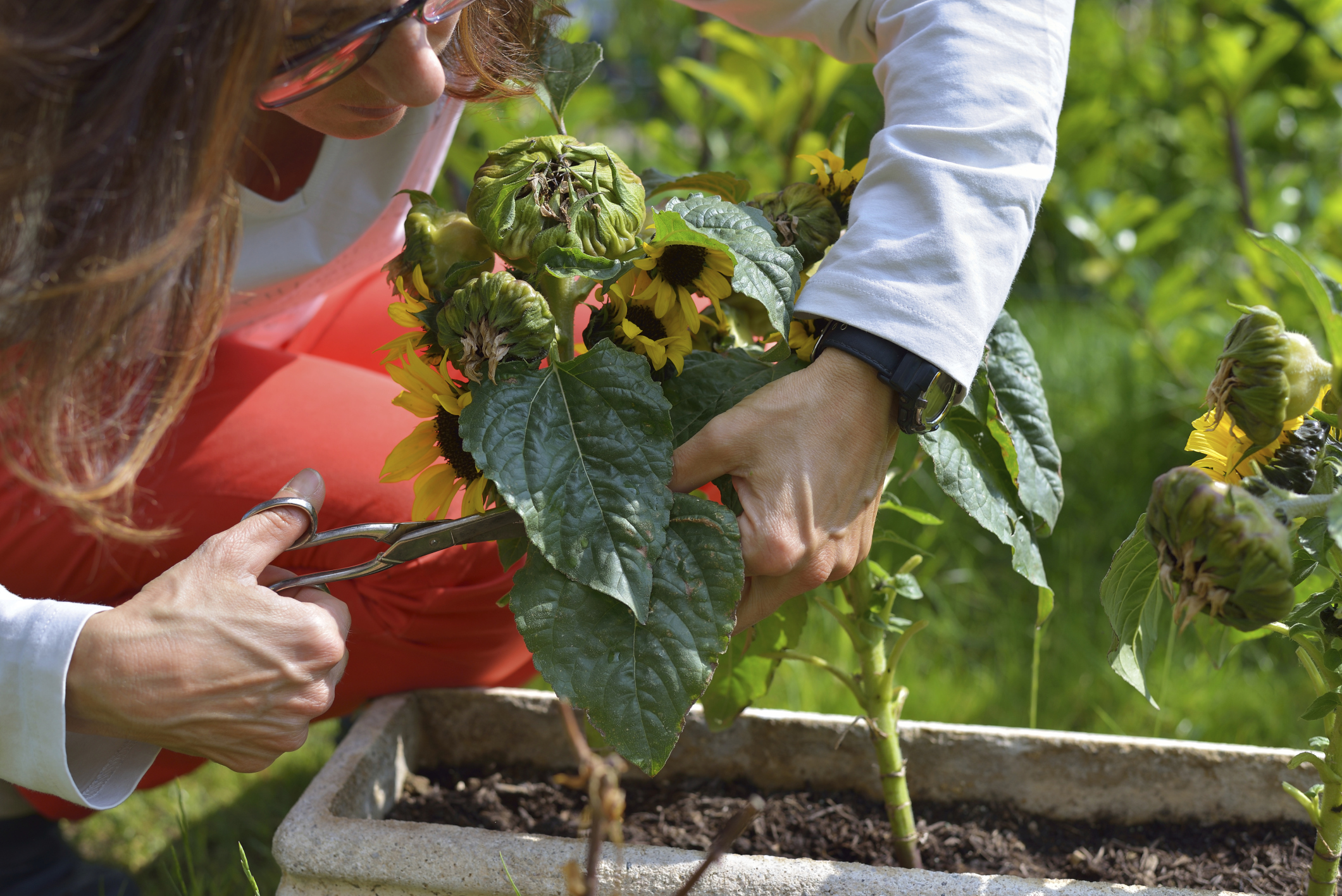Home>Types of Gardening>Ornamental Gardening>What Do You Do With Sunflowers After They Bloom
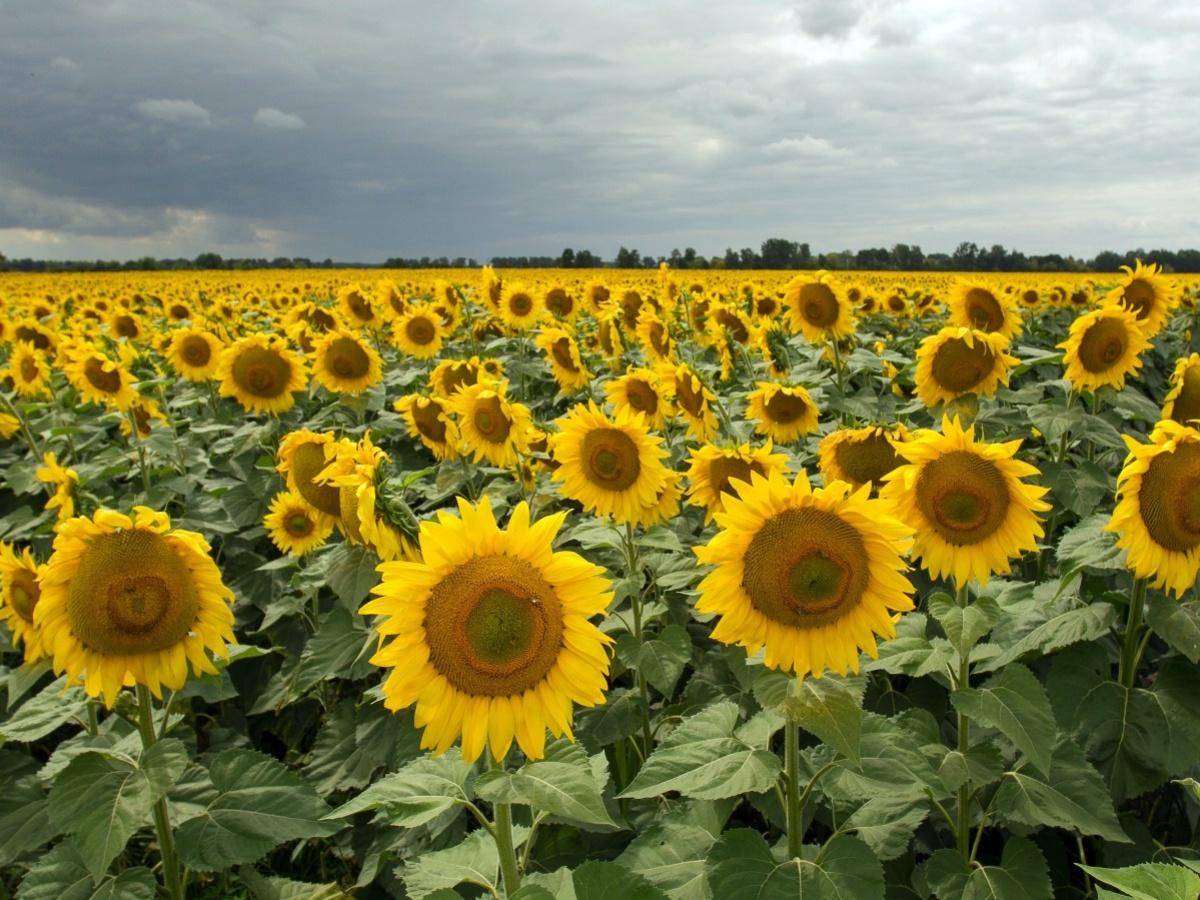

Ornamental Gardening
What Do You Do With Sunflowers After They Bloom
Modified: January 22, 2024
Discover the best practices for ornamental gardening! Learn what to do with sunflowers after they bloom to optimize the beauty and health of your garden.
(Many of the links in this article redirect to a specific reviewed product. Your purchase of these products through affiliate links helps to generate commission for Chicagolandgardening.com, at no extra cost. Learn more)
Table of Contents
- Introduction
- Understanding the Life Cycle of Sunflowers
- Enjoying the Beauty of Blooming Sunflowers
- Collecting Sunflower Seeds
- Harvesting Sunflower Heads for Decorative Purposes
- Drying Sunflowers for Arrangements and Crafts
- Feeding Sunflowers to Wildlife
- Using Sunflower Petals for Natural Dyes and Beauty Products
- Composting Sunflower Stalks and Leaves
- Conclusion
Introduction
Welcome to the world of ornamental gardening, where beauty blossoms and nature’s wonders unfold. Among the many stunning flowers that adorn our gardens, sunflowers stand tall and radiant, captivating our hearts with their vibrant colors and impressive size. These magnificent flowers not only bring joy during their blooming phase but also offer us an array of opportunities to extend their beauty even after they fade.
The life cycle of a sunflower is a remarkable journey that begins with a tiny seed and ends with a towering plant adorned with bright yellow or golden petals. As a passionate gardener, understanding how to care for sunflowers throughout their life cycle and what to do with them after they bloom can enhance your gardening experience and allow you to fully enjoy the beauty these flowers have to offer.
In this article, we will delve into various ways you can make the most of your sunflowers beyond their blooming phase. We will explore how to collect their seeds, harvest their heads for decorative purposes, dry them for crafts and arrangements, feed them to wildlife, utilize their petals for natural dyes and beauty products, and finally compost their stalks and leaves to nourish your garden.
So, if you’re ready to discover the endless possibilities that sunflowers have to offer, let’s dive in and explore the world of post-bloom sunflower care and utilization!
Understanding the Life Cycle of Sunflowers
Before we delve into what to do with sunflowers after they bloom, it’s important to have a solid understanding of their life cycle. Sunflowers go through several stages, each with its own unique characteristics and requirements.
The journey starts with a small seed planted in the soil. The seed germinates, sending out a root that anchors the plant and absorbs nutrients from the soil. Soon after, a sprout emerges, reaching towards the sunlight. As the stem grows taller, leaves start to develop and unfold, collecting energy through photosynthesis.
Once the sunflower reaches maturity, it enters its blooming phase, which is undoubtedly the star of the show. The flower head, composed of hundreds of individual florets, opens up to reveal a stunning display of yellow or golden petals. This stage attracts pollinators like bees and butterflies, ensuring the continuation of the sunflower’s life cycle.
After the blooming phase comes to an end, the petals gradually wilt and fall off. The flower head, now filled with seeds, transforms into a bounty of food for birds and other wildlife. Eventually, the sunflower plant begins to wither, signaling the completion of its life cycle.
Understanding the life cycle of sunflowers is crucial when it comes to post-bloom care. Each stage presents different opportunities for enjoyment and utilization. By recognizing the needs and characteristics of each phase, you can make the most of your sunflowers and continue to appreciate their beauty long after they bloom.
Enjoying the Beauty of Blooming Sunflowers
When sunflowers are in full bloom, they are a sight to behold. The vibrant hues of yellow and gold create a striking contrast against the green foliage, instantly brightening up any garden or landscape. During this stage, there are several ways to fully enjoy the beauty provided by these majestic flowers.
First and foremost, take the time to simply admire the sunflowers in all their splendor. Find a comfortable spot in your garden or create a seating area nearby where you can relax and soak in the beauty of these towering plants. Observe how the flowers sway in the breeze, their faces following the sun as it moves across the sky. It’s a tranquil and mesmerizing sight that can bring a sense of peace and serenity to your day.
Another way to appreciate the beauty of blooming sunflowers is by capturing their essence through photography. The bright petals and the intricate patterns of their centers make for captivating subjects. Experiment with different angles and lighting conditions to capture their beauty in unique and artistic ways. Share your photos with friends and family or display them as wall art to bring a touch of nature into your home.
If you want to incorporate the beauty of sunflowers into your daily life, consider bringing some blooms indoors. Cut sunflowers make stunning floral arrangements that can brighten up any room. Select a few freshly bloomed flowers and place them in a vase filled with water. Their cheerful presence will not only add a pop of color but also bring a sense of warmth and joy to your living space.
Lastly, don’t forget to involve others in the joy of blooming sunflowers. Host a garden party or invite friends and family over to share in the enchantment of your sunflower garden. Provide opportunities for them to interact with the flowers, whether it’s through taking photos, picking a few petals, or simply enjoying the ambiance. Sharing the beauty of sunflowers with others can create lasting memories and foster a deeper appreciation for the wonders of nature.
The blooming phase of sunflowers is a fleeting but extraordinary time. Embrace the beauty and find creative ways to enjoy their presence in your garden and everyday life.
Collecting Sunflower Seeds
One of the most rewarding aspects of growing sunflowers is the opportunity to harvest their seeds. Sunflower seeds are not only deliciously nutritious but also a versatile ingredient in cooking and baking. Here’s how you can collect and prepare sunflower seeds for your enjoyment:
As the sunflower heads begin to mature and turn brown, it’s time to gather the seeds. Start by cutting the heads from the plant, leaving a long stem attached. Place the cut heads in a clean, dry, and well-ventilated space, such as a garage or shed, to continue drying.
Once the heads are thoroughly dry, it’s time to remove the seeds. Gently rub the back of the sunflower head with your hands or use a fork to loosen the seeds. The seeds should easily fall out, but you may need to apply some pressure depending on their maturity.
To separate the seeds from the chaff, which is the husk and debris, you can use a simple winnowing technique. Stand outside on a windy day or use a fan indoors. Hold a container below and pour the seeds slowly in front of the wind source. The chaff will blow away, while the heavier seeds will fall into the container.
After winnowing, inspect the seeds for any remaining debris or husk remnants. You can further clean the seeds by rinsing them in a bowl of water and removing any floating particles. Spread the cleaned seeds on a baking sheet or a large flat surface to allow them to dry completely.
Once dried, the sunflower seeds are ready for consumption or storage. You can enjoy them as a healthy snack, add them to your favorite recipes, or use them for bird feeders during the winter months. If storing, place the seeds in an airtight container and store them in a cool, dry place to maintain their freshness.
Collecting sunflower seeds not only provides you with a delicious and versatile ingredient but also allows you to continue the life cycle of these magnificent flowers. Consider saving a portion of your harvested seeds for planting in the next growing season. Watching new sunflowers sprout from the seeds you collected is a rewarding experience that brings the cycle of life full circle.
Harvesting Sunflower Heads for Decorative Purposes
Besides their practical uses, sunflower heads can also serve as stunning decorative elements that bring a touch of nature’s beauty into your home. Harvesting sunflower heads for decorative purposes not only allows you to extend the enjoyment of these flowers but also adds a unique and rustic charm to your living spaces. Here’s how you can harvest and utilize sunflower heads for decorative purposes:
When the sunflower heads have fully bloomed and the petals have started to wilt and fall, it’s an indication that they are ready to be harvested for decorative purposes. Carefully cut the sunflower heads from the stems, leaving a few inches of the stem attached. It’s best to do this early in the morning or late in the evening when the foliage is well-hydrated.
Once you have harvested the sunflower heads, you can choose to leave them as they are or remove the seeds to create a cleaner appearance. Gently rub the back of the head or use a fork to loosen and separate the seeds from the florets. Collect the seeds for future use, and discard the remaining debris.
Now that you have the prepared sunflower heads, you can get creative with how you use them for decorative purposes. One popular option is to create stunning floral arrangements. Place the sunflower heads in a vase or container filled with water, and arrange them alongside other fresh or dried flowers, greens, or branches. The bright yellow or golden hues of the sunflower heads will make a bold statement and become the focal point of your arrangement.
If you prefer a more rustic and outdoorsy look, you can hang the sunflower heads upside down to dry. Tie a string or twine around the stem and hang them in a cool, dry, and well-ventilated area. Once completely dry, you can use them as charming wall decorations, door wreaths, or even incorporate them into seasonal crafts and DIY projects.
Another creative way to incorporate sunflower heads into your home decor is by using them as table centerpieces. Arrange the dried sunflower heads in a shallow dish or tray and add accents like candles, foliage, or decorative stones. This simple yet eye-catching centerpiece will add a touch of natural elegance to your dining table or any other surface in your home.
By harvesting sunflower heads for decorative purposes, you can extend their beauty beyond their blooming phase. These versatile and visually appealing elements will enliven your living spaces and serve as a constant reminder of the beauty of nature. Get creative and explore different ways to incorporate sunflower heads into your home decor for a truly unique and vibrant ambiance.
Drying Sunflowers for Arrangements and Crafts
Drying sunflowers allows you to preserve their natural beauty and extend their usability for various artistic endeavors. Whether you’re interested in creating dried flower arrangements or engaging in crafts, the process of drying sunflowers opens up a world of possibilities. Here’s a step-by-step guide on how to dry sunflowers for arrangements and crafts:
Begin by selecting sunflower heads that are fully mature but haven’t yet started to wilt or dry on the stalk. This stage ensures that the flowers are at their peak beauty and will retain their vibrant color during the drying process.
Once you’ve chosen your sunflower heads, cut them from the stalk, leaving a few inches of stem attached. Remove any leaves or foliage from the stem, as they can increase the chances of mold or rot during the drying process.
Gently tie a string or rubber band around the base of the stem of each sunflower head. Create a small bundle by grouping several sunflower heads together and securing them with a larger rubber band or twine.
Hang the bundles upside down in a dark, dry, and well-ventilated area. This could be a closet, a cool attic, or a dry room. Hanging them upside down allows for even air circulation and prevents the flowers from drooping or losing their shape as they dry.
Patience is key during the drying process, as it can take several weeks for the sunflowers to fully dry. Avoid touching or disturbing the flowers while they are drying, as this can cause damage or disrupt the drying process.
Check on the sunflowers regularly, inspecting them for any signs of mold or decay. If you notice any issues, promptly remove and discard the affected sunflower heads to prevent the spread of mold to the remaining flowers.
After the sunflowers have completely dried, they are ready to be used in arrangements or crafts. They will have a slightly different appearance than fresh sunflowers, as the petals may become more flattened and the colors may have slightly faded. However, this can add a unique and rustic charm to your creations.
To create dried flower arrangements, simply arrange the dried sunflowers in a vase or container of your choice. Add complementary dried flowers, foliage, or other natural elements like branches or grasses. The dried sunflowers will provide a long-lasting and visually appealing focal point to your arrangements.
If you’re interested in crafts, dried sunflowers can be used in various ways. You can create wreaths by attaching the heads to a wire or straw base, incorporate them into dried floral bouquets, or even use them in handmade greeting cards or pressed flower artworks.
Drying sunflowers for arrangements and crafts is a wonderful way to preserve their beauty and explore your creativity. The dried sunflowers serve as a reminder of the blooming phase and offer a unique and lasting touch to your artistic endeavors.
Feeding Sunflowers to Wildlife
Sunflowers not only bring joy and beauty to our gardens but also provide a valuable source of food for various wildlife. By intentionally leaving some sunflower heads on the plants or providing them as feeding stations, you can attract and support a variety of creatures in your backyard. Here’s how you can feed sunflowers to wildlife:
As sunflowers reach maturity and the petals start to wither, they begin to produce an abundance of seeds. These seeds are rich in essential nutrients and attract numerous bird species, including finches, sparrows, and chickadees. By allowing sunflower heads to remain on the plants, you can create a natural bird buffet.
Observe the sunflower heads closely to determine when they are ready to be offered to the wildlife. The seeds should be plump and fully developed, and the heads should be starting to turn brown. This indicates that the seeds are ripe and ready to be consumed.
Leave a few sunflower heads intact on the plants, or cut them and hang them from trees or poles using twine or wire. Make sure to secure them in a location that is easily accessible for the birds but protected from strong winds or predators.
Additionally, you can create your own bird feeders using the harvested sunflower heads. Attach a string or wire to the stem and hang them in areas where birds frequently visit, such as near bird feeders or in trees and shrubs.
Keep an eye on the feeders and sunflower heads, replenishing them as needed. Birds can quickly devour the seeds, especially during colder months when food becomes scarce. Regularly refilling the feeders ensures that your feathered friends have a continuous supply of nourishment.
It’s not just birds that benefit from sunflower seeds. Squirrels, chipmunks, and other small mammals are also attracted to the tasty treat. While they may try to raid the bird feeders or forage for seeds on the ground, you can provide dedicated feeding stations to encourage their presence.
Remember to clean and replace the feeders regularly to prevent the spread of diseases. Proper hygiene is crucial to maintain the health and well-being of the wildlife that visits your feeding stations.
Feeding sunflowers to wildlife not only supports their survival but also allows you to witness the beauty of these creatures up close. You’ll have the opportunity to observe their graceful flight, lively chirping, and playful antics as they enjoy the nutritious seeds provided by the sunflowers.
By embracing the role of a nurturing host to your local wildlife, you can forge a deeper connection with nature and contribute to the well-being of these fascinating creatures.
Using Sunflower Petals for Natural Dyes and Beauty Products
Sunflowers offer more than just their striking appearance and edible seeds – their petals can be utilized in various ways to create natural dyes and beauty products. The vibrant colors of sunflower petals can be extracted and transformed into dyes for fabrics, crafts, and even incorporated into homemade skincare products. Here’s how you can harness the potential of sunflower petals:
To create a natural dye using sunflower petals, start by harvesting the petals when they are in full bloom. Select petals that are vibrant in color and free from any blemishes or damage. Gently pluck the petals from the sunflower heads, being careful not to tear or bruise them.
Once you have collected a sufficient amount of petals, place them in a large pot and add enough water to cover them. Simmer the petals over low heat for about an hour, stirring occasionally. This process will extract the natural pigments from the petals and infuse the water with their color.
After simmering, strain the liquid to separate the petals from the dye. You can discard the petals or use them for composting or other purposes. The resulting liquid is your sunflower petal dye, ready to be used for various projects.
For fabric dyeing, soak the fabric you wish to dye in water to wet it thoroughly. Then, immerse the fabric in the sunflower petal dye and simmer it gently for an extended duration to achieve a deeper color. The longer you soak the fabric, the more intense the color will be. Once the desired color is achieved, rinse the fabric thoroughly with water until the excess dye runs clear, and let it air dry.
In addition to fabric dyeing, you can also incorporate sunflower petal dye into crafts such as papermaking, natural artwork, or even homemade candles. Experiment with different materials and techniques to unleash your creativity and explore the beautiful range of colors obtained from sunflower petals.
Furthermore, sunflower petals can be infused into oils or used to create floral waters for homemade beauty products. Harvest a handful of petals and place them into a clean glass jar. Pour a carrier oil, such as jojoba oil or almond oil, over the petals, making sure they are fully submerged. Seal the jar tightly and place it in a cool, dark location for a few weeks, allowing the petals to infuse the oil with their properties. Strain the oil to remove the petals, and you’re left with a fragrant and nourishing sunflower-infused oil that can be used in skincare, haircare, or massage products.
To extract floral water, simply steep the sunflower petals in distilled water and let them infuse for a few hours. Strain the petals, and you have a refreshing and fragrant floral water, also known as hydrosol, that can be used as a facial toner, body mist, or an ingredient in homemade cosmetics.
Using sunflower petals for natural dyes and beauty products allows you to embrace the beauty of nature while reducing your exposure to synthetic chemicals. Capture the essence and vibrant colors of sunflowers in your creative endeavors and pamper yourself with the nourishing qualities they possess.
Composting Sunflower Stalks and Leaves
While sunflowers bring beauty to our gardens, they also provide a valuable source of organic matter for composting. Composting sunflower stalks and leaves not only reduces waste but also enriches the soil and promotes a healthy garden ecosystem. Here’s how you can compost sunflower stalks and leaves:
Once the sunflowers have completed their life cycle and the stalks and leaves have turned dry and brown, it’s time to start the composting process. Cut the stalks at ground level using gardening shears or a sharp knife. If the stalks are too tall to fit into the compost bin, you can break them into smaller pieces to facilitate decomposition.
Break or shred the sunflower leaves into smaller pieces as well. This will speed up the composting process by increasing the surface area and allowing for better air circulation within the compost pile.
Next, create a compost pile or add the sunflower stalks and leaves to your existing compost bin or heap. To ensure proper decomposition, it’s important to have a balanced mix of “green” and “brown” materials. Sunflower stalks and leaves fall into the “brown” category, which provides carbon-rich material. To balance it, add “green” materials such as kitchen scraps, grass clippings, or other fresh plant matter.
Layer the sunflower stalks and leaves with the other compost ingredients, alternating between the “brown” and “green” materials. This helps create a well-aerated and balanced compost pile, allowing beneficial microorganisms to break down the organic matter more efficiently.
Regularly turn or mix the compost pile to provide oxygen and distribute moisture. This encourages decomposition and prevents the formation of anaerobic conditions that can lead to unpleasant odors. As the sunflower stalks and leaves break down, they will contribute to the overall nutrient-rich composition of the compost.
Monitor the moisture levels in the compost pile. It should be moist like a wrung-out sponge, but not overly saturated. If the pile becomes too dry, water it lightly. If it becomes too wet, add “brown” materials to absorb excess moisture.
Over time, the sunflower stalks and leaves will break down and decompose, transforming into crumbly, dark compost. This compost can then be used to enrich garden soil, boost plant growth, and improve overall soil health. It’s a natural and sustainable way to recycle the remains of sunflowers back into the earth.
As always, be mindful of any seeds that may still be present in the sunflower stalks and leaves. If you’re concerned about unwanted sunflowers sprouting in your compost, you can choose to hot compost your pile, which reaches higher temperatures to kill off any potential seeds.
Composting sunflower stalks and leaves not only reduces waste but also closes the cycle of life. It allows the nutrients and energy stored in these plants to be returned to the soil, benefiting future plants and perpetuating the incredible journey of nature.
Conclusion
Sunflowers are undeniably captivating and versatile plants that bring beauty and joy to gardens. From their impressive blooms to their nutritious seeds and vibrant petals, sunflowers offer a myriad of opportunities for enjoyment and utilization beyond their blooming phase.
Understanding the life cycle of sunflowers allows us to make the most of these magnificent plants. We can appreciate their beauty as they bloom, capturing stunning photographs, and creating breathtaking floral arrangements. By collecting sunflower seeds, we can savor their delicious flavor and use them in various culinary creations while also saving seeds for future plantings.
The dried sunflower heads make excellent materials for decorative purposes, adding a rustic charm to our homes and encouraging our creativity in various crafts and arrangements. Furthermore, sunflower petals can be transformed into natural dyes, adding vibrant colors to fabric and artistic projects. Infusing them into oils and creating floral waters allows us to harness their nourishing properties and incorporate them into homemade skincare and beauty products.
Feeding sunflowers to wildlife not only supports their survival but also provides an opportunity to witness the beauty and grace of birds and small mammals up close. By leaving sunflower heads for them to enjoy, we create a harmonious connection with nature and contribute to the well-being of our feathery and furry friends.
Finally, composting sunflower stalks and leaves allows us to close the cycle of life and utilize every part of the plant. By transforming them into nutrient-rich compost, we enrich our soil and create a sustainable approach to gardening.
In conclusion, sunflowers are not just beautiful flowers to admire; they are gifts from nature that provide us with food, beauty, creativity, and ecological benefits. Embrace the endless possibilities that sunflowers offer and let their splendor continue to grace your life long after they bloom.


